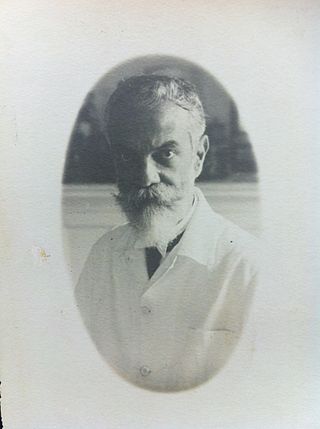
Samba is a name or prefix used for several rhythmic variants, such as samba urbano carioca, samba de roda, recognized as part of the Intangible Cultural Heritage of Humanity by UNESCO, amongst many other forms of samba, mostly originated in the Rio de Janeiro and Bahia States.

Plínio Salgado was a Brazilian politician, writer, journalist, and theologian. He founded and led Brazilian Integralist Action, a political party inspired by the fascist regime of Benito Mussolini.

Brazilian Integralism was a political movement in Brazil, created in October 1932. Founded and led by Plínio Salgado, a literary figure who was somewhat famous for his participation in the 1922 Modern Art Week. The movement had adopted some characteristics of European mass movements of those times, specifically of Italian fascism, but distancing itself from Nazism because Salgado himself did not support racism. He believed that every person of every race should unite under the Integralist flag. Despite the movement's slogan "Union of all races and all peoples", members and leaders like Gustavo Barroso held anti-Semitic views. The name of the party created to support its doctrine was Brazilian Integralist Action. The reference to Integralism mirrored a traditionalist movement in Portugal, the Lusitanian Integralism. For its symbol, the AIB used a flag with a white disk on a royal blue background, with an uppercase sigma (Σ) in its center.

Sebastião Ribeiro Salgado Júnior is a Brazilian social documentary photographer and photojournalist.

José Bonifácio de Andrada e Silva was a Brazilian statesman, naturalist, mineralist, professor and poet, born in Santos, São Paulo, then part of the Portuguese Empire.

The Archdiocese of São Sebastião do Rio de Janeiro in Brazil was established as a territorial prelature on July 19, 1575. It was elevated to the status of a diocese on November 16, 1676. It was later elevated to a metropolitan archdiocese on April 27, 1892. On May 6, 2003, the territorial abbey of Nossa Senhora do Monserrate do Rio de Janeiro lost its territorial rank and was added to the archdiocese. Cardinal Orani João Tempesta O. Cist. has been its Archbishop since 2009. Cardinal Eusébio Scheid S.C.I., who died on January 13, 2021, was Archbishop Emeritus.
Antônio Lopes dos Santos, usually known as Antônio Lopes is a Brazilian football head coach and former footballer.

The creation of art in the geographic area now known as Brazil begins with the earliest records of its human habitation. The original inhabitants of the land, pre-Columbian Indigenous or Natives peoples, produced various forms of art; specific cultures like the Marajoara left sophisticated painted pottery. This area was colonized by Portugal in the 16th century and given the modern name of Brazil. Brazilian art is most commonly used as an umbrella term for art created in this region post Portuguese colonization.

Lygia Pape was a Brazilian visual artist, sculptor, engraver, and filmmaker, who was a key figure in the Concrete movement and a later co-founder of the Neo-Concrete Movement in Brazil during the 1950s and 1960s. Along with Hélio Oiticica and Lygia Clark, she was an important artist in the expansion of contemporary art in Brazil and pushed geometric art to include aspects of interaction and to engage with ethical and political themes.

Alípio de Miranda-Ribeiro was a Brazilian herpetologist and ichthyologist. His son, Paulo de Miranda-Ribeiro (1901-1965) was also a zoologist.

Events in the year 1904 in Brazil.

Events in the year 1908 in Brazil.

Events in the year 1922 in Brazil.

Events in the year 1923 in Brazil.

Events in the year 1969 in Brazil.

Events in the year 1965 in Brazil.

Events in the year 1971 in Brazil.
Maria João Espírito Santo Bustorff SilvaGOM is a Portuguese restoration specialist, philanthropist and former politician. She is known for her historical and cultural restoration and preservation work in both Portugal and Brazil through the Ricardo Espírito Santo Foundation, and also for being Minister of Culture during the government of Prime Minister Pedro Santana Lopes.
PIPA Prize is a Brazilian arts award of the PIPA Institute. From 2010 to 2018, PIPA had a partnership with the Museum of Modern Art of Rio de Janeiro – MAM-Rio. In 2019, the PIPA Prize's exhibition was held at Villa Aymoré, in Rio de Janeiro, Brazil.

Agenor Moreira Sampaio, most commonly known as Mestre Sinhozinho, was a mestre or master practitioner of the Afro-Brazilian martial art of capoeira. He was the main exponent of the fighting-oriented style known as capoeira carioca.












